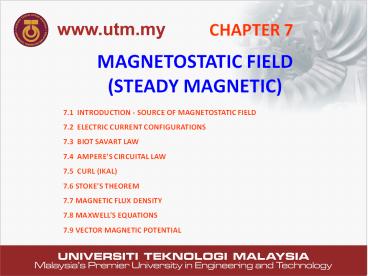MAGNETOSTATIC FIELD
Title: MAGNETOSTATIC FIELD
1
CHAPTER 7
MAGNETOSTATIC FIELD (STEADY MAGNETIC)
7.1 INTRODUCTION - SOURCE OF MAGNETOSTATIC FIELD
7.2 ELECTRIC CURRENT CONFIGURATIONS 7.3 BIOT
SAVART LAW 7.4 AMPERES CIRCUITAL LAW 7.5 CURL
(IKAL) 7.6 STOKES THEOREM 7.7 MAGNETIC FLUX
DENSITY 7.8 MAXWELLS EQUATIONS 7.9 VECTOR
MAGNETIC POTENTIAL
2
7.1 INTRODUCTION - SOURCE OF MAGNETOSTATIC FIELD
- Originate from
- constant current
- permanent magnet
- electric field changing linearly with time
3
Analogous between electrostatic and magnetostatic
fields
4
Two important laws for solving magnetostatic
field
- Biot Savart Law general case
- Amperes Circuital Law cases of symmetrical
current distributions
5
7.2 ELECTRIC CURRENT CONFIGURATIONS
Three basic current configurations or
distributions
6
7.3 BIOT SAVART LAW
Consider the diagram as shown
7
Total magnetic field can be obtained by
integrating
Similarly for surface current and volume current
elements the magnetic field intensities can be
written as
8
Ex. 7.1 For a filamentary current distribution
of finite length and along the z axis, find (a)
and (b) when the current extends from -?
to ?.
Solution
9
(No Transcript)
10
(b) When a - ? and b ?, we see that ?1
?/2, and ?2 ?/2
11
Solution
Using Biot Savart Law
and
12
Hence
13
Fig. 7.3 (a) Closely wound solenoid (b) Cross
section (c) surface current, NI (A).
14
Solution
- Total surface current NI Ampere
- Surface current density, Js NI / l Am-1
- View the dz length as a thin current loop that
- carries a current of Jsdz (NI / l )dz
Solution from Ex. 7.2
Hence
15
at the center of the solenoid
which is one half the value at the center.
16
Ex. 7.4 Find at point (-3,4,0) due to the
filamentary current as shown in the Fig. below.
Solution
Total magnetic field intensity is given by
17
Unit vector
Hence
18
Unit vector
Hence
Hence
19
7.4 AMPERES CIRCUITAL LAW
- Solving magnetostaic problems for cases of
symmetrical current distributions.
Definition
The line integral of the tangential component of
the magnetic field strength around a closed path
is equal to the current enclosed by the path
20
Graphical display for Amperes Circuital Law
interpretation of Ien
Path (loop) (a) and (b) enclose the total current
I , path c encloses only part of the current I
and path d encloses zero current.
I
(a)
(b)
(c)
(d)
21
Ex. 7.5 Using Amperes circuital law, find
field for the filamentary current I of infinite
length as shown in Fig. 7.6.
z
to ?
I
y
x
to -?
Fig. 7.6
22
(No Transcript)
23
Ex. 7.6 Find field above and below a surface
current distribution of infinite extent with a
surface current density
Solution
Graphical display for finding and using
Amperes circuital law
24
where
Therefore
Similarly if we takes on the path 3-3'-2'-2-3,
the equation becomes
Hence
25
In vector form
26
z
h
0
27
7.5 CURL (IKAL)
The curl of a vector field, is another
vector field.
For example in Cartesian coordinate, combining
the three components, curl can be written as
And can be simplified as
28
Expression for curl in cyclindrical and spherical
coordinates
cyclindrical
spherical
29
(No Transcript)
30
(a) for a
filamentary current
(b) in an
infinite current carrying conductor with radius
a meter
(c) for infinite sheet
of uniformly surface current Js
(d)
in outer conductor of coaxial cable
31
Solution
(a)
Cyclindrical coordinate
Hence
32
Solution
(b)
Cyclindrical coordinate
Hence
33
Solution
(c)
Cartesian coordinate
because Hx constant and Hy Hz 0.
Hence
34
Solution
(d)
Cyclindrical coordinate
Hence
35
7.6 STOKES THEOREM
36
It can be shown as follow
Consider an open surface S whose boundary is a
closed surface l
37
Hence
where loop l is the path that enclosed surface S
and this equation is called Stokes Theorem.
38
Solution
39
7.7 MAGNETIC FLUX DENSITY
Magnetic field intensity
40
In magnetics, magnet poles have not been isolated
4th. Maxwells equation for static fields.
41
Solution
42
7.8 MAXWELLS EQUATIONS
Electrostatic fields
Magnetostatic fields
43
7.9 VECTOR MAGNETIC POTENTIAL
To define vector magnetic potential, we start
with
magnet poles have not been isolated
gt
Using divergence theorem
ltgt
From vector identity
Therefore from Maxwell and identity vector, we
can defined if is a vector magnetic
potential, hence
44
(No Transcript)































